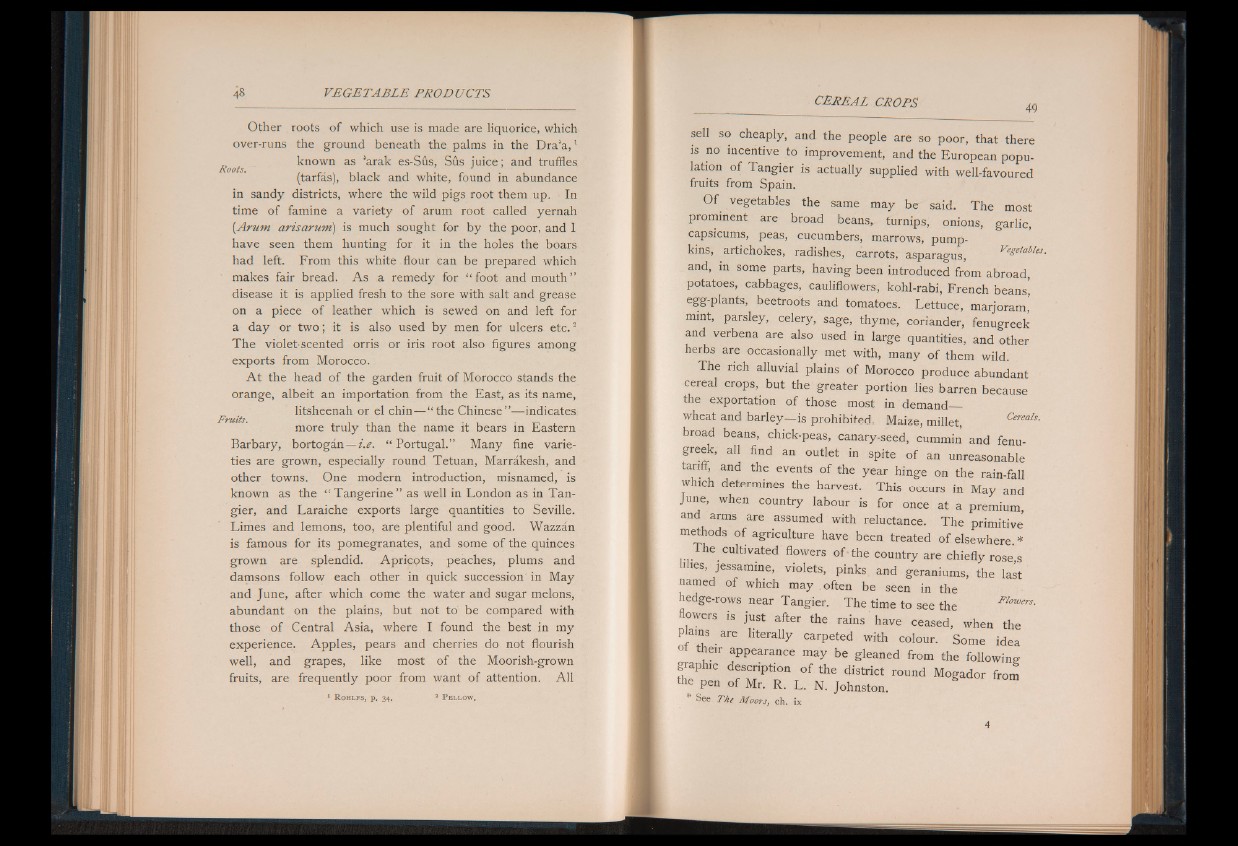
Other roots of which use is made are liquorice, which
over-runs the ground beneath the palms in the Dra'a,1
known as ‘arak es-Sus, Sus QOtS. , . juice; and truffles
(tarfas), black and white, found in abundance
in sandy districts, where the wild pigs root them up. In
time of famine a variety of arum root called yernah
{Arum arisarum) is much sought for by the poor, and 1
have seen them hunting for it in the holes the boars
had left. From this white. flour can be prepared which
makes fair bread. A s a remedy for “ foot and mouth”
disease it is applied fresh to the sore with salt and grease
on a piece of leather which is sewed on and left for
a day or tw o ; it is also used by men for ulcers etc.2
The violet-scented orris or iris root also figures among
exports from Morocco.
A t the head of the garden fruit of Morocco stands the
orange, albeit an importation from the East, as its name,
^ litsheenah or el chin -B“ the Chinese Nnndicates
more truly than the name it bears in Eastern
Barbary, bortogan— i.e. “ Portugal.” Many fine varieties
are grown, especially round Tetuan, Marrakesh, and
other towns. One modern introduction, misnamed, is
known as the “ Tangerine” as well in London as in Tangier,
and Laraiche exports large quantities to Seville.
Limes and lemons, too, are plentiful and good. Wazzan
is famous for its pomegranates, and some of the quinces
grown are splendid. Apricots, peaches, plums and
damsons follow each other in quick succession in May
and June, after which come the water and sugar melons,
abundant on the plains, but not to be compared with
those o f Central Asia, where I found the best in my
experience. Apples, pears and cherries do not flourish
well, and grapes, like most of the Moorish-grown
fruits, are frequently poor from want of attention. All
1 R o h l f s , p . 34. 2 F e l l o w .
c e r e a l c r o p s 49
sell so cheaply, and the people are so poor, that there
is no incentive to improvement, and the European population
of Tangier is actually supplied with well-favoured
fruits from Spain.
O f vegetables the same may be said. The most
prominent are broad beans,, turnips, onions, garlic,
capsicums, peas, cucumbers, marrows, pumpkins,
artichokes, radishes, carrots, asparagus,
and, in some parts, having been introduced from abroad,
potatoes, cabbages, cauliflowers, kohl-rabi, French beans,
egg-plants, beetroots and tomatoes. Lettuce, marjoram,’
mint, parsley, celery, sage, thyme, coriander, fenugreek
and verbena are also used in large quantities, and other
herbs are occasionally met with, many of them wild.
The rich alluvial plains o f Morocco produce abundant
cereal crops, but the greater portion lies barren because
the exportation o f those most in demand—
wheat and barley— is prohibited. Maize, millet, Cereals.
broad beans, chick-peas, canary-seed, cummin and fenugreek,
all find an outlet in spite of an unreasonable
tariff, and the events of the year hinge on the rain-fall
which determines the harvest. This occurs in May and
June, when country labour is for once at a premium,
and arms are assumed with reluctance. The primitive
methods o f agriculture have been treated of elsewhere *
The cultivated flowers of-the country are chiefly roses
lilies, jessamine, violets, pinks and geraniums, the la^t
named of which may often be seen in the
hedge-rows near Tangier. The time to see the lowers.
flowers is just after the rains' have ceased, when the
p ains are literally carpeted with colour. Some idea
their appearance may be gleaned from the following
graphic description o f the district round Mogador from
the pen of Mr. R. L. N. Johnston.
See The Moors, ch. ix